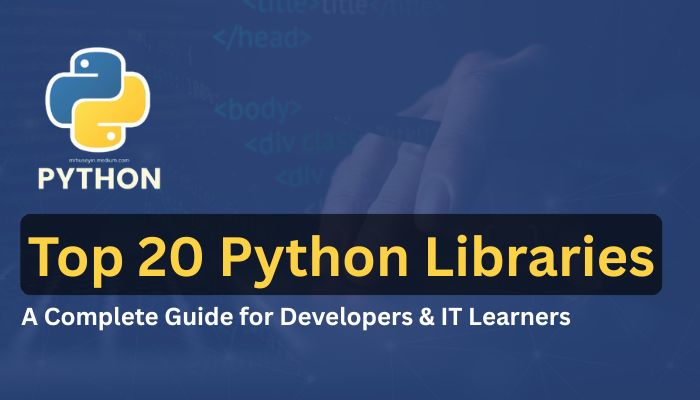Top 20 Python Libraries to Know in 2026

A Complete Guide for Developers & IT Learners
Python continues to dominate the world of programming in 2026—powering artificial intelligence, cloud computing, cybersecurity, automation, web development, and more. Whether you’re preparing for certifications, building real-world projects, or upskilling with advanced training at Intaglio Solutions, mastering the right Python libraries can transform your career. This blog highlights the top 20 Python libraries you must learn in 2026, along with key insights into what Python libraries are and why they are so beneficial.
What Is a Python Library?
A Python library is a collection of reusable functions, modules, and code packages designed to simplify complex programming tasks. Instead of writing everything from scratch, developers can import ready-made functions to handle tasks such as data analysis, machine learning, networking, automation, file handling, and more.
In simple terms, a Python library is a toolbox filled with powerful tools, helping programmers build applications faster, cleaner, and more efficiently.
Benefits of Python Libraries
Python libraries offer several advantages, making Python one of the most powerful programming languages in the world:
✔ Saves Time and Effort
You don’t need to reinvent the wheel—use pre-built functions to perform complex tasks instantly.
✔ Boosts Productivity
Libraries reduce development time, helping you focus on logic instead of boilerplate code.
✔ Ensures High-Quality Code
Most libraries are built by experts, ensuring optimized and well-tested functionalities.
✔ Supports Advanced Technologies
Python libraries are essential for AI, ML, cloud computing, automation, cybersecurity, and big data.
✔ Great for Learning and Training
Beginners and professionals can learn faster because libraries simplify complex concepts.
Top 20 Python Libraries to Know in 2026
Below are the most in-demand and widely used Python libraries that every programmer, analyst, or IT student should know in 2026.
1. NumPy – The Foundation of Scientific Computing
Used for numerical operations, arrays, and high-performance computations.
Essential for AI, ML, and data science projects.
2. Pandas – King of Data Analysis
Ideal for handling datasets, data cleaning, and manipulation. A must for data analysts and ML engineers.
3. Matplotlib – Powerful Data Visualization
Used for creating graphs, charts, histograms, and dashboards.
4. SciPy – Advanced Mathematical Functions
Great for engineering, optimization, integration, and scientific calculations.
5. Scikit-Learn – Machine Learning Made Easy
Provides ready-made algorithms for classification, clustering, regression, and ML modeling.
6. TensorFlow – Deep Learning Powerhouse
Used for neural networks, AI research, NLP, image processing, and automation.
7. PyTorch – The Researcher’s Favorite
Popular among AI developers for its dynamic computational graph and model flexibility.
8. Keras – Simplifying Deep Learning
Runs smoothly on TensorFlow; ideal for beginners and quick neural network prototyping.
9. OpenCV – Computer Vision Excellence
Used for facial recognition, object detection, surveillance systems, and robotics.
10. NLTK – Natural Language Processing Toolkit
Perfect for text analysis, chatbots, and voice recognition projects.
11. SpaCy – Industrial-Grade NLP Library
Faster and more efficient than NLTK; used in enterprise AI solutions.
12. Requests – Easy HTTP and API Handling
Helps connect Python apps with web servers, APIs, and cloud platforms.
13. Flask – Lightweight Web Development Framework
Perfect for building small to mid-size web apps, APIs, dashboards, and automation tools.
14. Django – High-Level Web Framework
Used for secure and scalable enterprise-grade web applications.
15. PyGame – Game Development Framework
A fun and interactive library for building 2D games and simulations.
16. Selenium – Browser Automation & Testing
Automates web tasks, browser testing, and scraping—popular in QA automation.
17. BeautifulSoup – Best for Web Scraping
Used to extract data from websites, blogs, news portals, and tables.
18. PySpark – Big Data Analysis
Used with Apache Spark for processing huge datasets in cloud environments.
19. FastAPI – High-Performance API Development
Increasingly popular in 2026 for building fast, asynchronous web APIs.
20. LangChain – AI & LLM Workflow Automation
A cutting-edge library for building applications using LLMs, agents, and generative AI workflows.
Why These Libraries Matter in 2026
Technology is evolving faster than ever. Companies across India, the USA, Singapore, and Europe demand Python developers who are skilled in automation, cloud, cybersecurity, machine learning, and AI. The libraries above support every major IT domain—making them essential for career growth.
Whether you are preparing for tech certifications, cracking job interviews, or building full-stack applications, these libraries will give you the competitive edge needed in 2026.
How Intaglio Solutions Helps You Master Python
At Intaglio Solutions, we provide industry-level Python and AI training designed for beginners and professionals. You get:
✔ Hands-on training with real projects
✔ 1:1 mentorship and interview preparation
✔ Certification-focused modules
✔ Deep learning, cloud AI, and automation skills
✔ Job readiness with practical applications
Our courses cover all essential Python libraries, ensuring you master both foundational and advanced concepts used in today’s IT industry.
Final Thoughts
Python remains the most powerful and versatile programming language in 2026, and its libraries continue to lead innovation in AI, ML, cloud, automation, and data science. Learning the Top 20 Python Libraries listed above will make you more employable, technically strong, and industry-ready.
Whether you’re an aspiring data scientist, cloud engineer, cybersecurity analyst, AI developer, or full-stack Python programmer—these libraries can shape your future.




